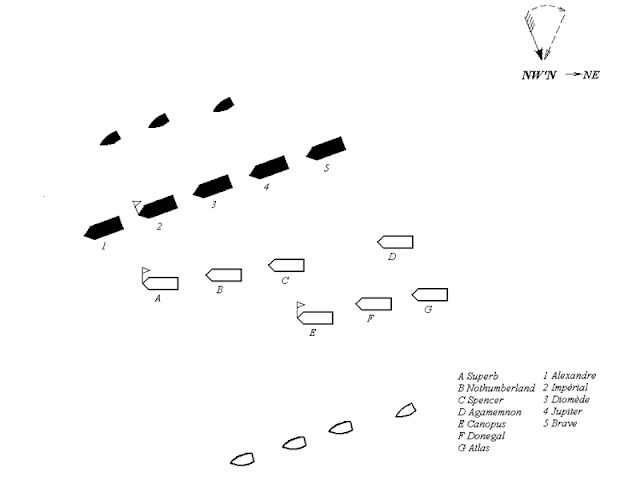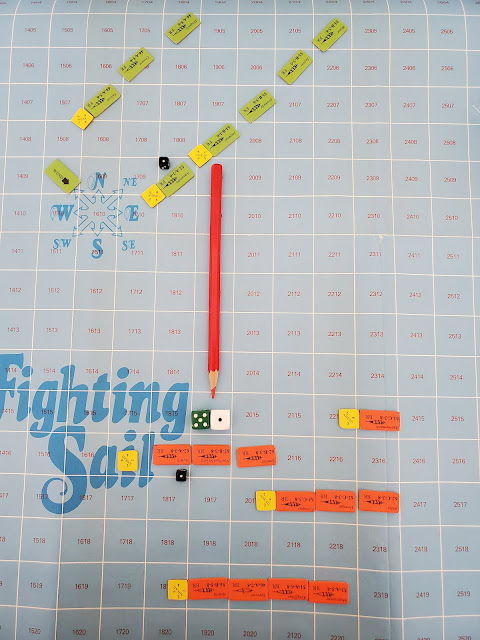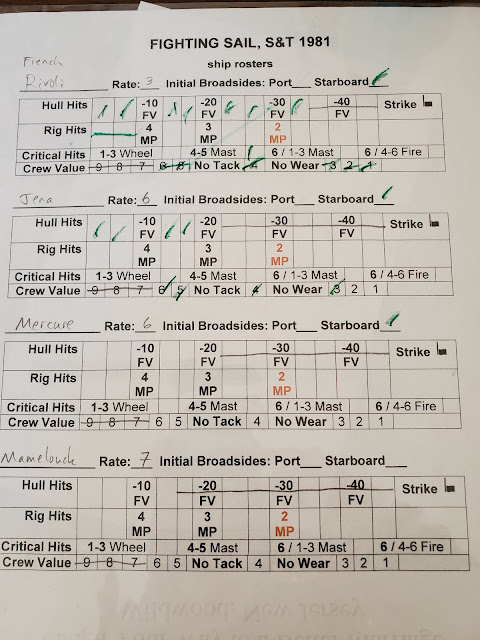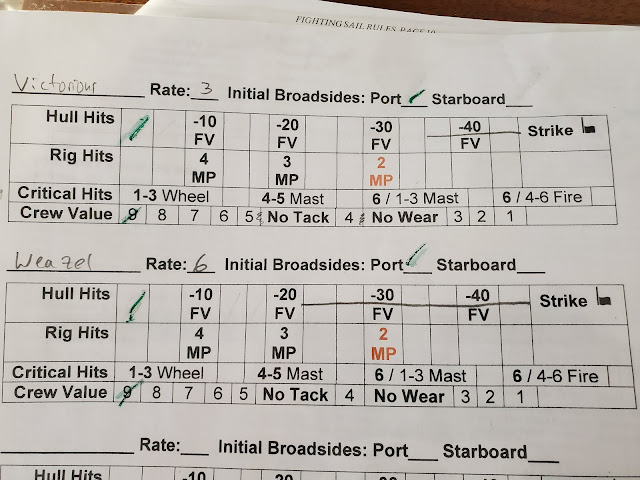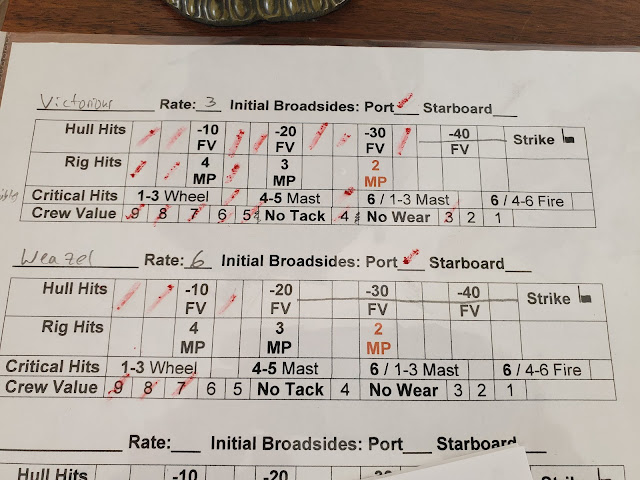Old Ducky may have My Touch...
When determining if a game has the right "feel", we need to consider if it gives us:
- Historical decisions the Commanders had, at the right level,
- Events and outcomes like the historical narratives we read,
- Opportunities for a different outcome to the battle, e.g. Napoleon wins Waterloo [if the French players play well], but in mechanics presents us with the likely results, keeping us in the 90%, 9% and 1% [typical, atypical, and once in a lifetime] of results.
For this, some analysis is required outside of game time, as we are usually too distracted when playing to do much figuring!
So in a set of naval wargame rules, how likely is the historical outcome for the naval battle of San Domingo, 1806? As I'm playing Fighting Sail [1981] these days, these are the rules I'll compare to history. However, I'll present a close description of the the battle that is good enough for you to compare your favorite rules out. I'll finish by examining if FS is likely to provide similar results if:
- players make the same decisions as the captains and admirals, and...
- the players roll about average and/or equally well.
As this was a very eventful battle, the victory conditions should give the French the ability to do better than their historical counterparts [like even one ship escaping?] and ideally should come down to the last few die rolls if both sides play equally well [note that this could be equally poorly, or equally excellently!].
In the analysis, the most important aspects of recreating this battle were the wind angle and the point of engagement between the two forces, which were not identical - the French had a First-rate 118-gun Ship of the Line.
Battle
of San Domingo, 1806 from Wikipedia [CLICK]
Note: the below account is mostly from the Wiki article, but I've re-organized and edited it for clarity and ease of following tactically.
At 06:00 on 6 February Duckworth's scouts sighted the
French, observing two frigates, five ships of the line and one large merchant
ship anchored in line at the entrance to Santo Domingo.[11]
The French hurriedly set sail. The
French Adm. Leissègues formed
a line of battle, Captain Pierre-Elie
Garreau in Alexandre leading with Impérial, Diomède, Jupiter and Brave
following. The frigates and corvette took a position Northwest between the
battle line and the shore.
At 08:00 Duckworth's ships divided into three
divisions:
- a
westerly battle line to windward under Duckworth with
Superb, Northumberland, HMS Spencer and HMS Agamemnon,
- an
eastern battle line under Louis with Canopus, HMS Donegal and Atlas.
- The four British frigates were in battle line to the west of the British battle lines,
awaiting orders to assist if required.[17]
Duckworth
was concerned that there might be
other French forces to the west. He therefore angled his line of attack to pass
across the front of the French line and signaled to his squadron to
direct their fire at the front three ships: Alexandre, Impérial and Diomède.[11]
Over the next two hours [16 Turns] the British slowly closed with the French squadron, the British divisions breaking up as the faster ships outpaced the slower. Louis' squadron fell behind Duckworth's, while Agamemnon dropped behind the other three vessels in Duckworth’s division, which otherwise remained in a tight formation. A slight shift in the wind allowed Leissègues to adjust his direction to the southwest, but the close presence of the land restricted French movements.
Looking at the scenario in FS1981, the British appear to be in the wrong place, on the French windward side, between them and the coast to Northwest [top left]. The French are already at the point of being engaged at the scenario start, and there is little time to maneuver without being fired upon.
The below diagram appears to be more in synch with the narrative, placing the British to leeward and between the French and the open sea.
At 10:00, on below
diagram, Hispaniola [Dominican Replublic] coastline is to the Northwest, from
which the wind is coming. Adm. Leissègues was
sailing from San Domingo southwest to Nizao, following the coast. Therefore
the French have little sea room to Windward [upwind], and the British fleet is
to Leeward [downwind].
image from
Wiki [CLICK]
On the game board, this would look something like this:
Note that the green and red die mark where the lead ships will be on Turn 3, and show the engagement point of close range Fire.
Analysis
from Wiki article, in game terms:
At 10:10 [Turn “1”] Superb was able to open fire on Alexandre.[18]
With the
British flagship engaged with the leading French vessel, Northumberland opened fire on the next in line, Leissègues'
flagship Impérial. The French ship carried 120 guns to Northumberland's 74, but Cochrane engaged closely, rapidly
supported by Spencer, which opened fire on Impérial and Diomède simultaneously. [18] For 15 minutes [two
Turns] the British continued to close, both squadrons sailing westwards along
the coast with the wind [both westwards and WITH the wind? So the wind is from the East then?].
At 10:25 [Turn 3], the damaged Alexandre suddenly swung out of the line in an attempt to
drive between Northumberland and Spencer [2nd and 3rd ships in Duckworth’s
first division] and rake them both. Captain Robert Stopford on Spencer responded rapidly, passing across Alexandre's bow and raking her, before turning along the opposite [far? Starboard?] side
of Alexandre and opening fire from close range. In the smoke and confusion
neither Superb nor Northumberland noticed Spencer's move; both fired several shots into Spencer before they realized their mistake.[19]
With Spencer and Alexandre out of the way, Impérial was able to engage both of the leading British
ships, threatening to overwhelm them. Cochrane moved to defend the flagship by pulling
Northumberland between Impérial and Superb, suffering terrible damage but preserving
Duckworth's ship intact. Impérial's fire was so heavy that several shot passed
straight through Northumberland into Superb.[20]
Destruction of Brave and Jupiter
in the French rear
As the combat raged at the head of the line, the remainder of
both squadrons strained [hurried?] to join the battle.
At 10:35 [Turn 4], the British eastern division under Adm. Louis reached the
battling Alexandre and Spencer the two ships locked [grappled?] together
to the south of the main engagement. As they passed, Canopus, Donegal and Atlas all [bow?] raked Alexandre, bringing down all her masts and leaving her in a crippled state.
Canopus then steered straight west – to join Superb and Northumberland around Impérial while Donegal and Atlas turned northwest to intercept Brave and Jupiter respectively.[17]
When Donegal moved alongside Jupiter, Captain Samuel Pym in Atlas abandoned his brief engagement with Jupiter and steered to join Canopus, Superb and Northumberland around Impérial Superb and Northumberland around Impérial .[21]
Captain Pulteney Malcolm on Donegal attacked Brave directly, firing his
starboard guns and then crossing Brave's stern, inflicting
severe damage with a raking broadside, before pulling alongside again and
engaging from close range.[17] Badly damaged, Brave surrendered. Malcolm then ordered Captain Richard Dunn in Acasta to take possession while he moved Donegal forward to engage Jupiter.
Taking advantage of Donegal‘s superior speed, Malcolm pulled ahead of Jupiter and then rammed her bow, securing the ships together to prevent
the French vessel from escaping. Recognising that further resistance was
hopeless, Captain Gaspard
Laignel surrendered immediately. Malcolm then sent 100 men on
board as a prize crew and attached a towline to the French ship, just as the
trailing Agamemnon finally reached the battle.[20]
At 11:00 [Turn 8], Spencer followed Canopus to join Donegal, Superb and Northumberland around Impérial as Alexandre's crew was preoccupied with extinguishing a fire on board. Alexandre was so badly damaged that she was unable to either escape or
continue the action; she formally surrendered ten minutes later.[21]
Admiral Leissègues
drives ashore
Under the shroud of heavy smoke that confused the positions and
identities of the ships at the head of the line, maneuvering became
hazardous: Atlas arrived and fired two
broadsides into Impérial then raked the French flagship
before her tiller jammed just as Diomède loomed
out the smoke. Receiving a heavy broadside from the French ship, Atlas subsequently
collided with Canopus as she too appeared immediately ahead, tearing off her bowsprit
in the collision.[21]
Turning back into the
battle, Atlas engaged Diomède at close
range as the rest of the British squadron concentrated their fire on the
beleaguered Impérial, with the exception of the damaged Northumberland, which
was drifting out of the line.[22]
At 11:30
[Turn 12], With his main and mizzen masts collapsed and escape impossible,
Leissègues turned his ship towards the shore outdistancing the fire from the
drifting Northumberland and leaving Superb behind; Duckworth
was reluctant to risk his ship in the shallow coastal shoals.[23] Canopus maintained
the pressure, pursuing the French flagship until it was clear at 11:40
that Impérial was hard aground on a coral reef,
less than a mile from the beach. Diomède, under
attack by Atlas and the recently returned Spencer,
followed Impérial ashore.
As they struck the reef, both
French ships lost their remaining masts and suffered severe damage to their
hulls. Their crews then gathered on deck and made preparations to abandon ship
as the British squadron pulled back out of range of fire from the shore.[24]
During the engagement the French
frigates and corvette had all slipped between the battling squadrons and the
shoreline and escaped to the westwards. The British frigates were too
preoccupied with boarding and towing prizes to initiate a chase.[25]
As Duckworth gathered his squadron, Northumberland's mainmast collapsed across the deck, causing severe damage to the
ship's fittings. Although Cochrane's flagship was the most severely damaged of
the squadron, all had suffered to a degree: Superb's men counted 60 shot holes while Atlas was out of control and Donegal had lost one of her topmasts.[26] Casualties were also
distributed throughout the fleet, with Northumberland and Spencer suffering the worst and Atlas the least except for the barely engaged Agamemnon. Total losses were 74
killed and 264 wounded and several ships were damaged, but Duckworth was
rapidly able to effect repairs as his ships remained on station to observe the
situation ashore.[27]
Impérial and Diomède had both run aground
between Nizao and Point Catalan, their hulls broadside to the beach and their
bottoms stove in by the reefs that lay offshore.[28] Using the remaining ship's
boats and with assistance from the shore, the wounded and survivors were
ferried to the beach.
Historical result: None but the French frigates survived. While the British fleet was badly damaged, since they held the field they were able to recover their own ships and those they captured. If any French ships of the line survive and escape, the French should get at least a minor victory.
Morale. Morale was clearly an important factor in the above narrative - some French ships surrendered quickly, while others fought it out. Therefore, it may be an issue for some players that there is no morale mechanic in FS - you just destroy hull boxes until the ship Strikes [surrenders]. Note that this does not include sinking, just Striking; ergo "Striking" in game terms may actually just mean enough hull damage that a ship will no longer fight. Given that it takes on average 7 Turns to force a typical 3rd Rate Ship of the Line to strike, which is 1 hour 45 minutes, that would synch with the 2-hour battle with no ships sinking but all Striking [or running aground...same thing].
- overall, depends on if you like a Morale Check mechanic to Strike sooner [or later], but the rules use a damage mechanic instead.
Ship Speeds. This is critical in any naval engagement, as the faster ships always have the choice of fight or flight, while the slower ships are forced to fight if the faster opponent wants to, and can't flee unless they damage the enemy ships and slow them down. [the other possibility is a surprise attack caused by low visibility, or the faster fleet is caught in harbor].
In this scenario, as set up according to the FS rules, the British may be in the wrong place historically, but they are in the right place to be able to catch the French ships and force an engagement! If you correct the British placement per the above historical narrative and switch the British from the French starboard to their port side, the French ships will "have the Weather Guage" and always be able to react second and shoot first by the FS rules. Being on a Beam Reach, gives all the French Sailing Value A ships 4 Movement Points [MP], while the British will all be at 3 MP, unless they immediately turn the Frigates to port.
Even using the rules for "Studding Sails" [might be better termed "Full Sail" or something - FS1981 doesn't have variable sail speeds, altho they'd be easy to tweak to do so, and I have] doesn't make a difference, as the French will still have a better wind angle and get more advantage from the Studding Sail rule:
Additionally, the presence of the 1st Rate Impérial is significant - it can easily engage ships much farther out due to how the Fire mechanic works - it uses a linear model and bigger ships easily make up for the range penalty with more guns. This translates into about 2-3 Turns of shooting first, depending on the wind angle. It's a bit like a battleship in a cruiser fight!
Above, note that the Impérial will hit on a 51 or less, so over 70% chance; Northumberland in return needs a 21 or less, about a 35% chance. Impérial also moves at the same speed as the 74's [which is historically accurate, it seems]. In one run-thru, Impérial managed to get four Hits on Northumberland before she could effectively reply! This also goes against the above historical narrative which states that the British opened fire on Alexandre first. Thus we see that the rules allow an engagement point that is much earlier and give the advantage to the French.
So, time to check another historical narrative!
Brian Tunstall's "Naval Warfare in the Age of Sail" published in 1990 [great book, btw] has the wind astern the British and French: "Duckworth immediately chased and with the wind almost directly astern of him, gained rapidly." This would make the wind from the East. If the British are gaining rapidly, and both sides' ships perform about the same, then the wind is likely East South East, astern the French but with the British just able to make a broad reach and force the engagement on the French who were trying to avoid a fight. Overall, this seems like the most likey combination of wind angle and sailing direction.
Interestingly, the Wiki article's most recent source is 2006, so the question is who is correct? The later books? According to the above narrative the French are heading west, turning a bit to southwest as contact is about to occur.
Another change for the scenario would be to switch the wind to come from the Southeast, heading to Northeast [the opposite of the scenario], which completes the change of the British to the French fleet's port side and still having a wind advantage. The deployment would now look something like the below:
Now there's no way for the French to escape without a fight. The British on Turn 1 will be at black die '1', same for French. But the Superb will be moving three squares a turn and quickly block Agamemnon's forward movement. She, and the French line, will have to turn a point to starboard, and start fighting it out. The alternative option would be to do something more radical, like a hard port turn, tack, and sail in an opposing direction to the British. They'd have to fool them at a key point, and it would affect their shooting a bit, but it is possible to do against a careless British player. The French may even destroy the trailing British ships.
This seems to put the engagement point of the two opposing squadrons at the right place, with the right wind and the right options. The French player will have to think outside the box and act boldly, but there's a good chance of doing better than the historical encounter!
So back to the original question, will FS 1981 give:
- Historical decisions the Commanders had, at the right level,
- Events and outcomes like the historical narratives for San Domingo above,
- Opportunities for a different outcome to the battle, but in mechanics presents us with the likely results, keeping us in the 90%, 9% and 1% [typical, atypical, and once in a lifetime] of results.
As presented in the FS rules [picture below], the scenario for San Domingo should easily have the British able to close assault the French - they start across their bows and ready to bow rake the lot, plus they've the Weather Gauge. I predict a similar outcome to history as long as:
- players make the same decisions as the captains and admirals, and...
- the players roll about average [at at least equally well].
The French could make a 90 turn to port, which would still leave them in that strange echelon formation, however the British are suffering from it also. This would enable Alexandre and Imperial the opportunity to batter Supurb while both sides straightened out their battle lines.
There is slim chance of the French doing better unless they immediately turn tail and run away, which is possible as the scenario rules don't prevent that! As FS gives the French ships better Sailing Values generally [B to C for most Ships of the Line] they may even get away with it.
In my modified and - seemingly - more historical scenario, the wind and ship locations will result in the British again having an advantage but this time it would be hard for the French to flee, so I predict another bruising encounter that would largely depend on the British player to make a few errors to lose.
Overall, my verdict is that both as originally presented [if not historically accurate] and as modified, Fighting Sail [S&T 1981] should give both sides an opportunity to re-fight history.
How do YOUR favorite rules stack up, you think?


